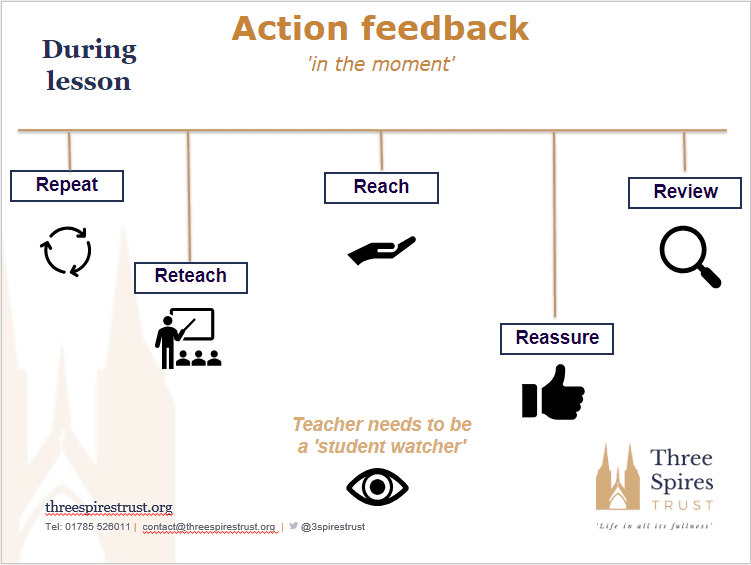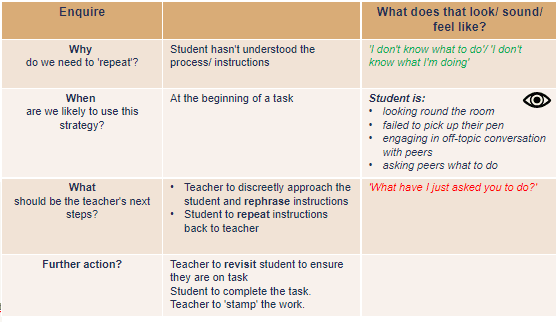Revolutionising classroom feedback: A practical approach to Dylan Wiliam’s vision

AIMEE WILLIAMS, DIRECTOR OF SCHOOL IMPROVEMENT, THREE SPIRES TRUST, UK
Introduction
In the ever-evolving landscape of education, the impact of influential figures like Dylan William cannot be overstated. For the uninitiated, his influential work on feedback in the classroom emphasises the importance of formative assessment as a powerful tool for improving student learning and ‘moving learning forward’ (Wiliam, 2018). He advocates for feedback that is timely, specific and actionable, fostering a continuous cycle of assessment and adjustment to enhance educational outcomes. While his insights have reached far and wide, the translation of his work into actionable classroom strategies remains a challenge. This article delves into an approach taken by one of our schools to bridge this gap, using Sherrington’s 5R model (2017), underpinned by Hattie and Timperley’s principles on ‘feed up, feedback, feed forward’ (2007). The school’s success in transforming feedback practices sheds light on the power of purposeful, tangible and effective action feedback.
Feedback
In 2016, a working group commissioned by the Department for EducationThe ministerial department responsible for children’s services and education in England (DfEDepartment for Education - a ministerial department responsible for children’s services and education in England, 2016) discovered that the excessive intensity, extent and regularity of marking was adversely impacting teachers’ wellbeing and hindering their capacity to strategise, organise and execute exceptional lessons. Marking had taken over our non-classroom working time, posing a threat to our health and, paradoxically, not having a ‘positive impact on pupils’ progress’ (DfE, 2016 p. 6). To some extent, one could argue that there were instances when we lost focus on the intended purpose of marking. Instead of serving as a tool to advance and enhance students’ learning, it had transformed into a superficial practice merely showcasing teacher engagement with the work.
The working group’s report, titled ‘Eliminating unnecessary workload around marking’, emphasised the need for our profession to reconsider its approaches to marking and feedback, not only for the wellbeing of staff but also for the rate of progress for our students (DfE, 2016). Acknowledging the comprehensive research carried out by the Education Endowment Foundation on ‘feedback in the moment’ (EEF, 2021), recognised for its ‘very high impact… for very low cost’ (EEF, nd), we were convinced that this approach justified the investment.
The 5R model: Repeat, reteach, reach, reassure, review
As leaders of teaching and learning, committed to enhancing feedback efficacy in the classroom, we recognised the need for there to be an imperative shift from generic evaluations, garnered from staff randomly circulating in the classroom, to providing students with actionable and specific guidance based on strategic targeting. Acknowledging the limitations of a ‘one size fits all’ approach to feedback, we embarked on implementing an adapted version of Sherrington’s 5R model that placed a profound emphasis on a teacher’s ability to assess the room before actioning meaningful and purposeful feedback, as illustrated in Figure 1. Every student possesses unique characteristics, and their reactions to lessons exhibit variability. By taking the time to assess the classroom dynamics before engaging with students, teachers can strategically pinpoint individuals who may require additional assistance or clarification. We labelled this the ‘student watcher’ episode – an integral step in the process of action feedback, which gave teachers time to observe their learners. This crucial step has also aided our efforts to enhance student engagement and accountability within the classroom. As the teacher observes, students are provided with dedicated ‘think time’, enabling them to participate in independent practice before any teacher intervention occurs (Kettlewell, 2022).

Figure 1: Action feedback process
- Primarily, we underscored the repeat phase, urging teachers to offer further clarification to those students who they observed may not have grasped the task initially
- Reteach hinges on teachers’ robust subject knowledge and their adeptness at reframing concepts to ensure comprehensive understanding
- The reach phase emphasises providing specific instructions for students to enhance their work, maintaining a balance between task manageability and suitable challenge
- Reassure becomes pivotal for students’ personal development, swiftly identifying and addressing self-doubt to instil confidence in their potential for success
- Finally, review signifies a departure from ‘retrospective marking’, encouraging teachers to propel ‘learning forward’ using a range of metacognitive strategies (Sherrington, 2017), granting students greater agency in their teaching and learning journey.
Implementation through instructional coaching
The success of the 5R model lies not only in its theoretical framework but also in its meticulous execution within the classroom.
Instructional coaching emerges as a powerful catalyst for effective pedagogical change, offering a structured partnership between classroom teachers and instructional coaches. This collaborative approach facilitates incremental improvements in pedagogical practices through continuous cycles of coaching and observation, targeting specific aspects of classroom practice one at a time. The transformative potential of instructional coaching lies in its ability to create and develop new habits for teachers, a critical factor, especially when research indicates that teachers make the most significant improvements in the early years of their careers. As improvement tends to slow down over time, likely due to habit formation, instructional coaching becomes a key strategy with which to break through ‘ingrained habits and adopt new behaviours’ (Winston, 2024). Linked to the principles of developing expertise through deliberate practice, instructional coaching involves setting precise sub-goals, designing targeted practice and providing ‘specific feedback’ – a departure from the judgment-focused observations prevalent in many schools (Huntington Research School, 2020). This approach ensures that feedback is not only specific about what needs to change but also guides teachers on how to make those changes, ultimately contributing to one of the strongest evidence bases for any form of continuous professional development (CPD) with a mechanism-rich impact on student outcomes.
The role of scripting in 5R implementation
Scripting played a crucial role in ensuring the successful implementation of the 5R model in our classrooms. By asking teachers to consider exactly what they would say before delivering feedback, scripting provided a set of carefully crafted phrases tailored to each of the 5R actions – redraft, rehearse, revisit, relearn and research. This approach required teachers to make conscious decisions about language choices in order to achieve the desired results, creating a systematic and deliberate practice to ‘enhance the quality of instruction’ (Knight, 2000).
In training sessions, scripting became an integral part of the instructional coaching approach, demystifying common teaching scenarios. Teachers were guided to choose a scenario, model how they would handle it and then write down their script. This process encouraged collaboration and feedback-sharing, allowing educators to refine their language for optimal impact. Scripting therefore became a tool for new and experienced teachers alike, aiding in the mastery of instructional building blocks and fostering rapid improvement. It additionally enabled us to reduce the likelihood of initiative burnout. This occurs when staff, lacking a clear understanding of how to execute an initiative, attempt it, face failure and subsequently abandon it, with the rationale that ‘it did not work’.
In addition to this, we urged teachers to contemplate the behaviours that they would anticipate in the classroom when a student needs specific feedback, as seen in Figure 2. For instance, if a student fails to start the task promptly, appearing off-task and disengaged, it could indicate a lack of understanding or uncertainty about the task. In such cases, a teacher might consider employing the Repeat script.

Figure 2: Example scripting
The practice of scripting
As we adapted to new procedures, scripting played a pivotal role in shaping the school culture, especially amid the challenges brought by the COVID-19 pandemic. Staff CPD sessions utilised scripting to introduce and reinforce clear, concise and positive language aligned with school values. Phrases such as ‘What have I just asked you to do?’, ‘Show me you can’ and ‘Thank you for…’ became shared scripts, fostering a consistent and positive school environment. The collective effort in scripting allowed for smooth implementation of new systems and garnered positive responses from both staff and students alike.
The importance of scripting in implementing the 5R model goes beyond mere words; it becomes a strategic approach to deliberate and thoughtful communication. By planning language in advance, scripting empowers teachers to navigate complex classroom scenarios, ensuring consistency and fostering a positive school culture. As an integral part of teacher development, scripting, when used in tandem with the 5R model, becomes a dynamic force for impactful feedback and continual improvement in the educational landscape.
The school’s success story highlights the transformative potential of purposeful action feedback in the classroom. By adopting the 5R model and aligning it with recent research on effective feedback practices, educators can ensure that their feedback leads to tangible improvements in student outcomes. As education continues to evolve, the emphasis on actionable feedback not only enhances learning but also positively impacts the wellbeing of both educators and students, creating a dynamic and motivating learning environment.
- Department for Education (DfE) (2016) Eliminating unnecessary workload around marking. Available at: https://assets.publishing.service.gov.uk/government/uploads/system/uploads/attachment_data/file/511256/Eliminating-unnecessary-workload-around-marking.pdf (accessed 16 March 2024).
- Education Endowment Foundation (EEF) (nd) Feedback. Teaching and Learning Toolkit. Available at: https://educationendowmentfoundation.org.uk/education-evidence/teaching-learning-toolkit/feedback (accessed 18 March 2024).
- Education Endowment Foundation (EEF) (2021) Teacher feedback to improve pupil learning: Guidance Report. Available at: https://d2tic4wvo1iusb.cloudfront.net/production/eef-guidance-reports/feedback/Teacher_Feedback_to_Improve_Pupil_Learning.pdf?v=1710677235 (accessed 18 March 2024).
- Hattie J and Timperley H (2007) The power of feedback. Review of Educational Research 77(1): 81–112.
- Huntington Research School (2020) Instructional coaching and early career teachers. Available at: https://researchschool.org.uk/huntington/news/instructional-coaching-and-early-career-teachers (accessed 5 January 2024).
- Kettlewell J (2022) Modelling independence – the ‘seven step model’ planning tool. In: EEF blog. Available at: https://educationendowmentfoundation.org.uk/news/eef-blog-modelling-independence-the-seven-step-model-planning-tool (accessed 10 January 2024).
- Knight J (2009) The big four: A simple and powerful framework to dramatically improve instruction. Strategram 21(4): 1–7.
- Sherrington T (2017) Five ways of giving effective feedback as actions. In: Teacherhead. Available at: https://teacherhead.com/2017/12/18/fiveways-of-giving-effective-feedback-as-actions (accessed 26 October 2018).
- Wiliam D (2018) Embedded Formative Assessment, 2nd ed. Bloomington, IN: Solution Tree Press.
- Winston E (2024) Verbal reference, SSAT conference, 16 January 2024.











I enjoyed this article. I found the 5Rs approach to be very thought-provoking. I’m keen to know the source of the ‘repeat example script’ and if there are other example scripts available to review and adapt?